8th Std Science Lesson Wise Questions in English – Part 1
8th Science Lesson 7 Questions in English
7] Plant Kingdom
1. Which of the following are different in living organisms?
- Habit
- Habitat
- Mode of nutrition
- Physiology
- 1, 2, 4
- 2, 3, 4
- 1, 3, 4
- All the above
Explanation
The living organisms found on the earth are different in their structures, habit, habitat, mode of nutrition and physiology. The estimated number of species on the earth is 8.7 million.
2. How many species are living on land?
- 6.5 million
- 2.5 million
- 8.7 million
- 4 million
Explanation
The estimated number of species on the earth is 8.7 million. Among them 6.5 million (1 million =10 lacks) species are living on land, 2.2 million species in the ocean. In these 4,00,000 species are flowering plants.
3. Which of the following are included in plant kingdom?
- Thallophytes
- Bryophytes
- Pteridophytes
- Gymnosperms
- 1, 2, 3
- 1, 3, 4
- 2, 3, 4
- All the above
Explanation
The living organisms show lot of similarities and differences so that they can be arranged into many groups systematically. The plant kingdom includes thallophytes, bryophytes, pteridophytes, gymnosperms and angiosperms.
4. Taxonomy is the branch of biology that deals with the study of______
- Identification
- Description
- Classification
- Nomenclature
- 4 alone
- 1, 2
- 2, 3, 4
- All the above
Explanation
Taxonomy is the branch of biology that deals with the study of identification, classification, description and nomenclature of living organisms.
5.The word ‘Taxonomy’ was first coined by_____
- Carolus Linnaeus
- Augustin-Pyramus de Candolle
- Bentham and Hooker
- Karl Marx
Explanation
The word taxonomy is derived from two Greek words (Taxis: arrangement and Nomos: laws.) The word ‘Taxonomy’ was first coined by Augustin-Pyramus de Candolle.
6. How many types of classification are there?
- 2
- 3
- 6
- 4
Explanation
There are four types of classification.
1. Artificial system of classification 2. Natural system of classification 3. Phylogenetic system of classification 4. Modern system of classification
7. _____is the earliest system of classification in plants
- Artificial system of classification
- Phylogenetic system of classification
- Natural system of classification
- Modern system of classification
Explanation
Artificial system of classification is the earliest system of classification in plants. Plants are classified on the basis of one or few morphological characters
8. Who proposed artificial system of classification?
- Carolus Linnaeus
- Augustin-Pyramus de Candolle
- Bentham and Hooker
- Karl Marx
Explanation
The most famous artificial system of classification is Linnaeus classification which was proposed by Carolus Linnaeus in Species plantarum.
9. _____ classification is an example of Natural System of Classification.
- Carolus Linnaeus
- Augustin-Pyramus de Candolle
- Bentham and Hooker
- Nino de Cuna
Explanation
In this system, plants are classified on the basis of several characters. Bentham and Hooker’s classification is an example of Natural System of Classification. This system of classification is based on morphological and reproductive characters of the seeded plants.
10. Who published their book named Genera Plantarum in 3 volumes?
- Carolus Linnaeus
- Augustin-Pyramus de Candolle
- Bentham and Hooker
- Nino de Cuna
Explanation
Bentham and Hooker published their Natural system of Classification in their book named Genera Plantarum in 3 volumes.
11. ____________ is defined as the collection of pressed, dried plants pasted on a sheet and arranged according
to any one of the accepted systems of classification
- Bonsai
- Herbaria
- Dela curzo
- Berlio
Explanation
Natural system of classification is widely used in many Herbaria (herbarium is defined as the collection of pressed, dried plants pasted on a sheet and arranged according to any one of the accepted systems of classification) and botanical gardens all over the world.
12. The division spermatophyta are divided into_____ classes
- 3
- 4
- 5
- 6
Explanation
The division spermatophyta are divided into 3 classes:
- Dicotyledonae
- Gymnospermae
- Monocotyledonae
13. Which of the following statement about Dicotyledonae is correct?
- seed has two cotyledons
- Fibrous root system is present
- Flowers are tetramerous or pentamerous
- 1, 2
- 1, 3
- 2, 3
- All the above
Explanation
Dicotyledonae:
- Seed has two cotyledons.
- Leaves have reticulate venation
- Tap root system is present.
- Flowers are tetramerous or pentamerous
14. Which of the following plant class have no fruit?
- Dicotyledonae
- Gymnospermae
- Monocotyledonae
- All the above
Explanation
Gymnospermae (Naked seed plants):
- Plants of this class have no fruit.
- It has three families, they are
1. Cycadaceae
2. Coniferae
3. Gnetaceae
15. Which of the following statement about Monocotyledonae is correct?
- Leaves have reticulate venation
- Fibrous root system is present
- Flowers are Trimerous
- 1, 2
- 1, 3
- 2, 3
- All the above
Explanation
Monocotyledonae:
- Seed has single cotyledon.
- Leaves have parallel venation.
- Fibrous root system is present
- Flowers are Trimerous
16. Binomial name of mango is_______
- Mangifera indica
- Solanum tuberosome
- Mangifera sativa
- Solanum indica
Explanation
The naming of an organisms with two words are known as Binomial Nomenclature. For example, the binomial name of mango is Mangifera indica.
17. Thalamiflorae comes under_________
- Dicotyledonae
- Gymnospermae
- Monocotyledonae
- All the above
Explanation
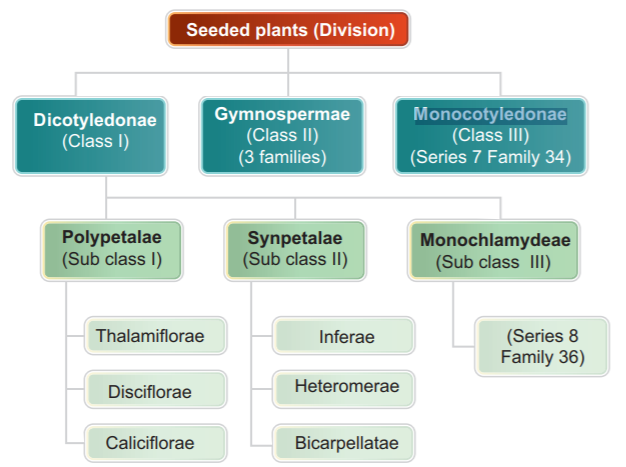
18. Binomial system had been properly made used by________
- Carolus Linnaeus
- Augustin-Pyramus de Candolle
- Bentham and Hooker
- Nino de Cuna
Explanation
Binomial system had been properly made used by Linnaeus in his book, “Species Plantarum.” The naming of an organisms with two words are known as Binomial Nomenclature.
19. Binomial name was first introduced by_________
- Carolus Linnaeus
- Augustin-Pyramus de Candolle
- Bentham and Hooker
- Gaspard Bauhin
Explanation
The system of naming the plants on scientific basis is known as Botanical nomenclature. Binomial name was first introduced by Gaspard Bauhin in the year of 1623.
20. Largest Herbarium of India is in________
- Chennai
- Mumbai
- Kolkata
- Lucknow
Explanation
Largest Herbarium of India is in Kolkata, which has more than 10,00,000 (one million) species of herbarium specimens.
21. _____ are chlorophyll bearing simple, primitive plants and are autotrophs.
- Algae
- Virus
- Bacteria
- Protozoan
Explanation
Algae are chlorophyll bearing simple, primitive plants and are autotrophs. Most of the algae are living in aquatic region. It may be fresh water or marine water. Very few algae can survive in terrestrial conditions.
22. Algae belongs to______
- Bryophytes
- Thallophytes
- Pteridophytes
- Gymnosperms
Explanation
Algae belongs to Thallophyta, and the plant body of algae are called thallus. i.e. the plant body is not differentiated into root, stem and leaf.
23. Algae floating on water are called as__________
- Phytoplankton
- Zooplankton
- Lichen
- All the above
Explanation
Some algae are very minute and float on the surface of the water. These algae are called Phytoplankton.
24. What is the full form of ICBN?
- International Code of Botanical Nomenclature
- Indian Council of Botanical Nomenclature
- Indian Code of Botanical Nomenclature
- International Code of Binomial Nomenclature
Explanation
The rules and recommendations regarding binomial nomenclature were found in ICBN (International Code of Botanical Nomenclature) now it is known as ICN (International Code of Nomenclature).
25. Algae living with fungi are called as_____
- Symbionts
- Epiphytes
- Saprophytes
- Parasites
Explanation
Some of the algae are symbionts (algae living with fungi and they both are mutually benefitted.) e.g. Lichen. A few species of them are epiphytes (growing on another plants).
26. Unicellular motile algae_________
- Chlorella
- Spirogyra
- Chlamydomonas
- Cladophora
Explanation
Plant body of the algae are unicellular or multicellular. Unicellular motile (Chlamydomonas), nonmotile. (Chlorella).
27. Multicellular unbranched filaments algae_______
- Chlorella
- Spirogyra
- Chlamydomonas
- Cladophora
Explanation
Multicellular unbranched filaments (Spirogyra) and branched filaments (Cladophora). Some algae are giant kelp – Macrocystis. Some algae are living as colonial form – Volvox. Alga like Chara resembles largest plant body and it possess well developed sex organs.
28. Match the following with algae with their method of reproduction:
- Vegetative reproduction 1. Chara
- Asexual reproduction 2. Spirogyra
- Sexual reproduction 3. Chlamydomonas
- 2, 1, 3
- 2, 3, 1
- 1, 3, 2
- 3, 1, 2
Explanation
Three types of reproduction are seen in algae:
• Vegetative reproduction by fragmentation e.g. Spirogyra.
• Asexual reproduction by spore formation e.g. Chlamydomonos.
• Sexual reproduction by means of fusion of gametes e.g. Spirogyra, Chara
29. Match the following:
- Bluegreen algae 1. Fucoxanthin
- Green algae 2. Phycocyanin
- Brown algae 3. Chlorophyll
- Red algae 4. Phycoerythirin
- 3, 1, 2, 4
- 2, 3, 1, 4
- 2, 1, 3, 4
- 4, 2, 1, 3
Explanation
Class – Type of pigment
Bluegreen algae – Phycocyanin
Green algae – Chlorophyll
Brown algae – Fucoxanthin
Red algae – Phycoerythirin
30. Match the following
- Bluegreen algae 1. Rhodophyceae
- Green algae 2. Chlorophyceae
- Brown algae 3. Phaeophyceae
- Red algae 4. Cyanophyceae
- 4, 1, 2, 3
- 4, 1, 3, 2
- 4, 2, 3, 1
- 1, 2, 4, 3
Explanation
- Bluegreen algae (Cyanophyceae)
- Green algae (Chlorophyceae)
- Brown algae (Phaeophyceae)
- Red algae (Rhodophyceae)
31. Match the following algae class with their Reserve food material:
- Bluegreen algae 1. Starch
- Green algae 2. Cyanophycean Starch
- Brown algae 3. Laminarian starch and Manitol
- Red algae 4. Floridian Starch
- 2, 1, 3, 4
- 1, 2, 3, 4
- 1, 3, 4, 2
- 3, 1, 2, 4
Explanation
- Bluegreen algae (Cyanophyceae) – Cyanophycean Starch
- Green algae (Chlorophyceae) – Starch
- Brown algae (Phaeophyceae)- Laminarian starch and Manitol
- Red algae (Rhodophyceae)- Floridian Starch
32. Which of the following algae are consumable?
- Ulva
- Chlorella
- Spirulina
- 1, 2
- 1, 3
- 2, 3
- All the above
Explanation
Algae are consumed as food by the people in Japan, England and also in India. e.g. Ulva, Spirulina, Chlorella etc. Some algae are used as a food for domestic animals. e.g. Laminaria, Ascophyllum.
33. _____algae are essential for the fixing of atmospheric nitrogen into the soil
- Green
- Blue green
- Brown
- Red
Explanation
Some of the blue green algae are essential for the fixing of atmospheric nitrogen into the soil, which increases the fertility of the soil. e.g. Nostoc, Anabaena.
34. Agar Agar is extracted from ________ algae
- Green
- Blue green
- Brown
- Red
Explanation
Agar Agar is extracted from some red algae, namely Gelidium, Gracillaria, etc., which is used to prepare growth medium in laboratories.
35. _____is used in space travel to get rid of CO2 and decompose human wastes
- Ascophyllum
- Laminaria
- Chlorella pyrenoidosa
- Gelidium
Explanation
Chlorella pyrenoidosa is used in space travel to get rid of CO2 and decompose human wastes. Iodine is obtained from brown algae like Laminaria (kelp).
36. Fungi (singular – fungus) belongs to____
- Bryophyta
- Thallophyte
- Pteridophyte
- None
Explanation
Fungi (singular – fungus) belongs to thallophyta because the plant body is not differentiated into root, stem, and leaves.
37. Which of the following statement is correct?
- The plant body of fungus consists of filament like structures called as hyphae
- Several hyphae arranged in the form of network called mycelium.
- There are three types of mycelium found in fungi, namely septate mycelium and aseptate mycelium.
- 1, 2
- 1, 3
- 2, 3
- All the above
Explanation
The plant body of fungus consists of filament like structures called as hyphae. Several hyphae arranged in the form of network called mycelium. There are two types of mycelium found in fungi, namely septate mycelium and aseptate mycelium.
38. If the cross wall is seen between the cell, it is called______
- Septate mycelium
- Aseptate mycelium
- Coenocytic mycelium
- None
Explanation
If the cross wall is seen between the cell, it is called septate mycelium. If the cross wall is not seen, it is called aseptate mycelium. When aseptate mycelium contains many nuclei, it is called as coenocytic mycelium .
39. Yeast cells are____ and____ organisation
- Unicellular, Eukaryotic
- Multicellular, Eukaryotic
- Multicellular, Prokaryotic
- Unicellular, Prokaryotic
Explanation
The cells of fungi are multicellular and eukaryotic organisation. Some species of fungi like yeast is unicellular and eukaryotic cell.
40. Cell wall of fungi is made up of__________
- Cellulose
- Cytoplasm
- Chitin
- Flagella
Explanation
Cell wall of fungi is made up of a chemical substance called chitin. The reserve food materials of fungi are glycogen and oil.
41. Fungi are_________
- Parasites
- Saprophytes
- Symbionts
- 1, 2
- 1, 3
- 2, 3
- All the above
Explanation
Fungi have no starch because they have no chlorophyll pigments. So, they are heterotrophs. Heterotrophs are of three types called parasites, saprophytes and symbionts.
42. Which of the following statement is incorrect?
- Parasites absorbs food from the living organisms with the help of special root called haustoria
- Cercospora personata affects groundnut plants and cause Tikka disease
- 1 alone
- 2 alone
- 1, 2
- None
Explanation
Parasites absorbs food from the living organisms with the help of special root called haustoria. e.g. Cercospora personata. It affects groundnut plants and cause Tikka disease.
43._____ grow up on the dead and decay matters
- Parasites
- Saprophytes
- Symbionts
- All the above
Explanation
Heterotrophs are of three types called parasites, saprophytes and symbionts. Saprophyte grow up on the dead and decay matters and get food from them. e.g. Rhizopus.
44. Fungi living symbiotically with higher plants roots called____
- Lichen
- Mycorrhizae
- Rhizopus
- Cercospora
Explanation
Some species of fungi living with algae and are mutually benefitted. e.g. Lichen. Some fungi live symbiotically with higher plants roots called Mycorrhizae
45. Which of the following anti-biotic are obtained from fungi?
- Erythromycin
- Penicillin
- Neomycin
- 1, 2
- 1, 3
- 2, 3
- All the above
Explanation
Penicillin (Penicillium notatum), Neomycin, Gentamycin, Erythromycin are some antibiotics obtained from fungi, which cure variable diseases.
46. Mushroom contains rich_____
- Protein
- Vitamin B
- Minerals
- 1, 2
- 1, 3
- 2, 3
- All the above
Explanation
Mushroom contains rich protein and minerals. The most common edible mushroom is Agaricus. (Button mushroom).
47. Which of the following is used to produce vitamin B2?
- Mycorrhizae
- Lichen
- Ashbya gospii
- Penicillium notatum
Explanation
Fungus like Ashbya gospii and Erymothecium ashbyii are used to produce vitamin B2 (riboflavin). Fungus like yeast contain enzymes invertase and zymase, which ferment the sugar molasses into alcohol.
48. Who placed fungus as 3rd kingdom in 5 kingdom classification?
- Charles Darwin
- RH Wittekar
- Louis Martin
- W. Martin
Explanation
Fungi placed as third kingdom in RH Wittekar’s five kingdom classification because absence of chlorophyll and starch.
49. When did W. Martin classified fungi?
- 1991
- 1961
- 1962
- 1996
Explanation
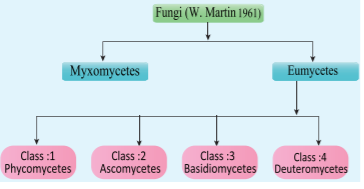
50. Match the following
- Fusarium oxisporam 1. White rust of radish
- Colletotrichum falcatum 2. Wilt disease of cotton
- Pyricularia oryzae 3. Red rot of sugar cane
- Albugo candida 4. Blast disease of paddy
- 2, 1, 3, 4
- 2, 3, 4, 1
- 3, 2, 1, 4
- 1, 2, 4, 3
Explanation
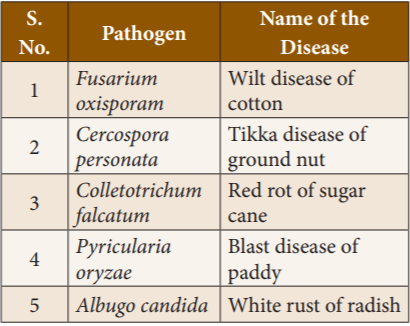
51. Which of the following gives greatest damages to the frustrated youth by giving unreal, extraordinary lightness?
- Aspergillus
- Cladosporium
- Claviceps purpuriya
- Albugo candida
Explanation
Claviceps purpuriya is the hallucinogenic fungi causes greatest damages to the frustrated youth by giving unreal, extraordinary lightness and hovering sensations
52. __________ species cause allergy to children
- Aspergillus
- Cladosporium
- Claviceps purpuriya
- Albugo candida
Explanation
Aspergillus species cause allergy to children while Cladosporium protects against allergy. Fungus like yeast contain enzymes invertase and zymase, which ferment the sugar molasses into alcohol.
53. Match the following
- Trichophyton sp 1. Ring worm
- Microsporum furfur 2. Athletes foot
- Tinea pedis 3. Dandruff
- 1, 3, 2
- 1, 2, 3
- 3, 1, 2
- 2, 1, 3
Explanation
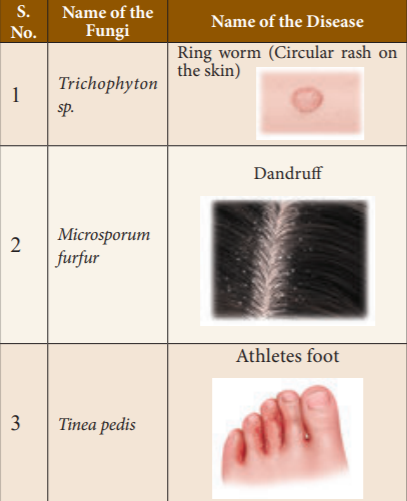
54. Which of the following statement is incorrect?
- Bryophytes are the primitive and simplest group of land plants.
- These are terrestrial and non-vascular cryptogams
- 1 alone
- 2 alone
- 1, 2
- None
Explanation
- Bryophytes are the primitive and simplest group of land plants.
- These are terrestrial and non-vascular cryptogams (they have no vascular tissues like xylem, phloem).
55. Queen of medicine is___________
- Neomycin
- Penicillin
- Erythromycin
- Gentamycin
Explanation
Queen of medicine is Penicillin, discovered by Sir Alexander Fleming in 1928. Fungi are heterotrophs.
56. Which of the following is called as amphibians of plant kingdom?
- Thallophyte
- Bryophyte
- Pteridophyte
- All the above
Explanation
Water is essential to complete their life cycle, so Bryophyte plants are called amphibians of the Plant Kingdom.
57. Which of the following statement about Bryophyte is correct?
- Sexual reproduction is oogamous type
- The male sex organ is antheridium, which produces antherozoid.
- The female sex organ is archegonium which contains an egg.
- 1, 2
- 1, 3
- 2, 3
- All the above
Explanation
General Characters of Bryophytes:
- Sexual reproduction is oogamous type
- The male sex organ is antheridium, which produces antherozoid.
- The female sex organ is archegonium which contains an egg.
58._________ is the first cell which develops into sporophytic generation
- Nematode
- Zygote
- Antheridia
- Archegonia
Explanation
Zygote is the first cell which develops into sporophytic generation and produce haploid spore (n) by meiosis. Spore is the first cell of the gametophytic generation.
59. Match the following
- Hepaticae 1. Funaria
- Anthocerotae 2. Riccia
- Musci 3. Anthoceros
- 2, 1, 3
- 2, 3, 1
- 1, 3, 2
- 3, 2, 1
Explanation
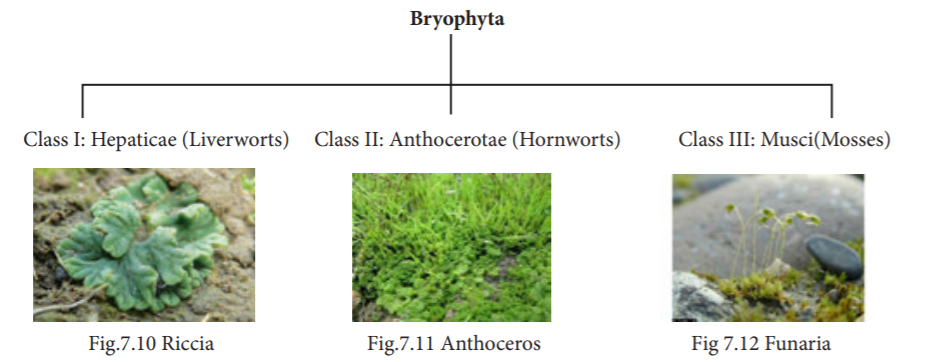
60. Which of the following statement about Hepaticae is correct?
- These are lower forms of bryophytes
- Protonemal stage is absent
- Sporophyte is very simple and short lived.
- 1, 2
- 1, 3
- 2, 3
- All the above
Explanation
Class I: Hepaticae (e.g. Riccia)
• These are lower forms of bryophytes. They are simple in structure than moss.
• Protonemal stage is absent. Sporophyte is very simple and short lived.
61. Which of the following statement about Anthocerotae is correct?
- Gametophyte is undifferentiated thallus, rhizoids are unicellular and unbranched
- Protonemal stage is present
- Sporophyte is differentiated into foot and capsule only
- 1, 2
- 1, 3
- 2, 3
- All the above
Explanation
Class–II: Anthocerotae
• Gametophyte is undifferentiated-thallus, rhizoids are unicellular and unbranched.
• Protonemal stage is absent. Sporophyte is differentiated into foot and capsule only.
62. Which of the following are economic importance of Bryophytes?
- Bryophytes prevent the soil erosion
- Sphagnam can absorb large amount of water.
- Peat is a valuable fuel like coal obtained from Sphagnum.
- 1, 2
- 1, 3
- 2, 3
- All the above
Explanation
Economic Importance of Bryophytes:
- Bryophytes prevent the soil erosion.
- Sphagnam can absorb large amount of water. Hence, it is used by the gardeners in nursery
- Peat is a valuable fuel like coal obtained from Sphagnum.
63. ____ moss was once used in disposable diapers
- Penicillium
- Sphagnum
- Lichen
- Riccia
Explanation
Sphagnum moss was once used in disposable diapers, because it soaks liquid well. Sphagnum is used in horticulture.
64. ____ are the first true land plants with xylem and phloem
- Bryophyte
- Thallophyte
- Pteridophyte
- None
Explanation
Pteridophytes are the first true land plants with xylem and phloem. Hence it is called vascular cryptogams.
65. Which of the following statement about pteridophyte is correct?
- The main plant body is sporophytes, which is the dominant phase, differentiated into true root, stem and leaves.
- The sporangia bearing leaves are called sporophyll.
- Sporophytes reproduce by means of spores. Spores are produced in sporangium
- 1, 2
- 1, 3
- 2, 3
- All the above
Explanation
General Characters of Pteridophyte:
The main plant body is sporophytes, which is the dominant phase, differentiated into true root, stem and leaves. Sporophytes reproduce by means of spores. Spores are produced in sporangium. The sporangia bearing leaves are called sporophyll.
66. _____ are used as ornamental plants
- Lichens
- Mosses
- Ferns
- Rhizome
Explanation
Ferns are used as ornamental plants. The rhizome and petioles of the Dryopteris yield the vermifuge drug.
67. ____ is known as club moss
- Lichens
- Mosses
- Ferns
- Lycopodium
Explanation
Lycopodium, is known as club moss. Equisetum is known as horse tail. The sporocarp of Marsilea (water fern) is used as food by tribal people.
68. _____ are naked seed plants
- Gymnosperms
- Angiosperms
- Bryophyte
- Pteridophyte
Explanation
Gymnosperm are naked seed plant, i.e. the ovule is not enclosed by ovary. Gymnosperms have two phases in its life cycle. (Sporophytic and Gametophytic)
69. Which of the following statement about Gymnosperm?
- Plant body is sporophyte dominant which is differentiated into root, stem and leaf
- The water conducting tissue is tracheid.
- They have cone on which sporangia and spores are produced.
- 1, 2
- 1, 3
- 2, 3
- All the above
Explanation
General Characters of Gymnosperms:
- Plant body is sporophyte dominant which is differentiated into root, stem and leaf.
- They have well developed vascular tissues. (xylem and phloem)
- The water conducting tissue is tracheid. Food conducting tissue is sieve cell
- They have cone on which sporangia and spores are produced.
70. Which of the following statement is correct?
- Woods of many conifers are used in the paper industries. e.g. Pinus, Agathis
- Conifers are the sources of soft wood for construction, packing and plywood industry e.g. Cedrus, Agathis
- 1 alone
- 2 alone
- 1, 2
- None
Explanation
Economic Importance of Gymnosperms:
- Woods of many conifers are used in the paper industries. e.g. Pinus, Agathis
- Conifers are the sources of soft wood for construction, packing and plywood industry e.g. Cedrus, Agathis
71. _____ is an essential oil used for paint preparation extracted from the resin of Pinus
- Olive
- Turpentine
- Gingelly
- All the above
Explanation
Turpentine is an essential oil used for paint preparation extracted from the resin of Pinus. It is also used medicinally to get relief from pain and bronchitis etc.,
72. _____ is an ornamental plant.
- Pinus gerardiana
- Ephedra
- Araucaria bidwillii
- None
Explanation
- Seeds of Pinus gerardiana are edible.
- Ephedrine is an alkaloid extracted from Ephedra. It cures asthma and respiratory problems.
- Araucaria bidwillii is an ornamental plant.
73. What does the term angio mean in angiosperms?
- Open
- Closed
- Semi closed
- Empty
Explanation
The term ‘Angiosperm ’is derived from two Greek words, i.e. ‘Angio’ which means box or closed and ‘sperma’ which means seed.
74. __________ are called flowering plants
- Angiosperms
- Gymnosperms
- Bryophylum
- Pteridophyte
Explanation
Angiosperms are called flowering plants. In this group more than 4,00,000 living species are found. They occupy every habitat on earth except extreme environment. (extreme hot and cold conditions).
75. Which of the following Leaves are pinnately compound forming a crown?
- Cycadales
- Ginkgoales
- Coniferales
- Gnetales
Explanation
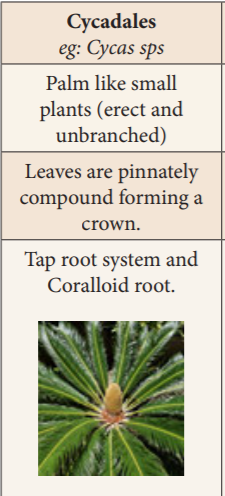
76. Which of the following produce unpleasant smell?
- Cycadales
- Ginkgoales
- Coniferales
- Gnetales
Explanation
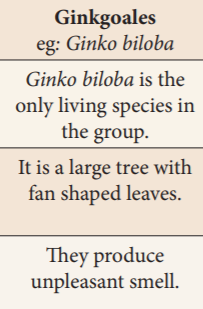
77. Which of the following Seeds are winged and produced in female cone?
- Cycadales
- Ginkgoales
- Coniferales
- Gnetales
Explanation
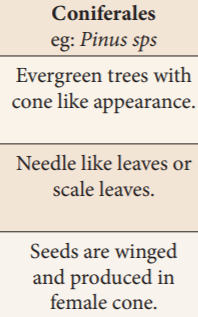
78. Which of the following possesses advanced characters like Angiosperm?
- Cycadales
- Ginkgoales
- Coniferales
- Gnetales
Explanation
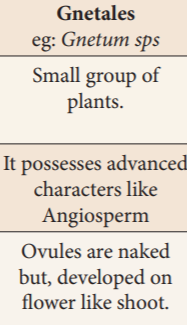
79. Which of the following is not found in xylem?
- Sieve tubes
- Tracheid
- Xylem fibre
- Xylem parenchyma
Explanation
Xylem contains vessel, tracheid, xylem parenchyma and xylem fibre. Phloem contains sieve tubes, phloem parenchyma, companion cells and phloem fibres.
80. Which of the following are the Characteristic features of monocotyledons?
- Seed has only one cotyledon
- Pollination occurs mostly by wind.
- Flowers are trimerous and not differentiated in to calyx and corolla.
- 1, 2
- 1, 3
- 2, 3
- All the above
Explanation
Characteristic features of monocotyledons:
- Seed has only one cotyledon.
- Plants have fibrous root system, leaves with parallel venation.
- Flowers are trimerous and not differentiated in to calyx and corolla.
- Pollination occurs mostly by wind.
- E.g. Grass, Paddy, Banana.
81. Which of the following is not a dicotyledon?
- Neem
- Mango
- Bean
- Rice
Explanation
Characteristic features of Dicotyledons:
- Seed has two cotyledons.
- Plants have tap root system, leaves with reticulate venation.
Flowers are tetramerous or pentamerous. Calyx and corolla are well differentiated.
- Pollination occurs mostly by insects.
- E.g. Bean, Mango, Neem
82. Acalypha indica belongs to___________
- Euphorbiaceae
- Rutaceae
- Oraziyae
- Liliaceae
Explanation
Acalypha indica (Kuppaimeni) belongs to the family Euphorbiaceae. The paste obtained from the leaves of this plant is used to cure the burns on the skin.
83. What is the common name of Aegle marmelos?
- Kuppaimeni
- Vilvam
- Thoodhuvalai
- Sothu Katrazhai
Explanation
Aegle marmelos (Vilvam) belongs to the family Rutaceae. The unripe fruit of this tree is used to treat indigestion. It is used to cure chronic, diarrhoea and dysentery.
84. Phyllanthus amarus common name_____________
- Keezhanelli
- Thoodhuvalai
- Sothu Katrazhai
- Vilvam
Explanation
Phyllanthus amarus (Keezhanelli) belongs to the family Euphorbiaceae. The entire plant is used for the treatment of jaundice. It gives additional strength to human liver and used to treat other liver disorders.
85. Which of the following can cure peptic ulcer?
- Aegle marmelos
- Phyllanthus amarus
- Solanum trilobatum
- Aloe vera
Explanation
Aloe vera belongs to the family Liliaceae. Leaves of this plant is used to cure piles and inflammations on the skin. It cures peptic ulcer.